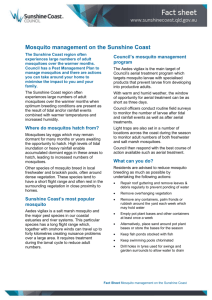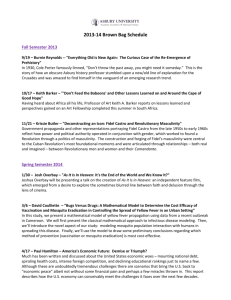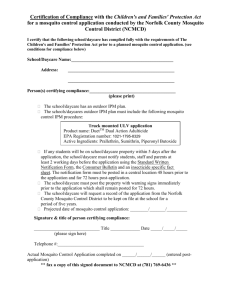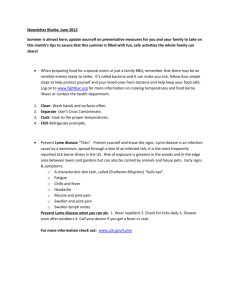EFFECTIVENESS OF “MOSQUITO SPRAYING” ON SPENCER BRANCH WITHIN Brandi N. Stewart
advertisement
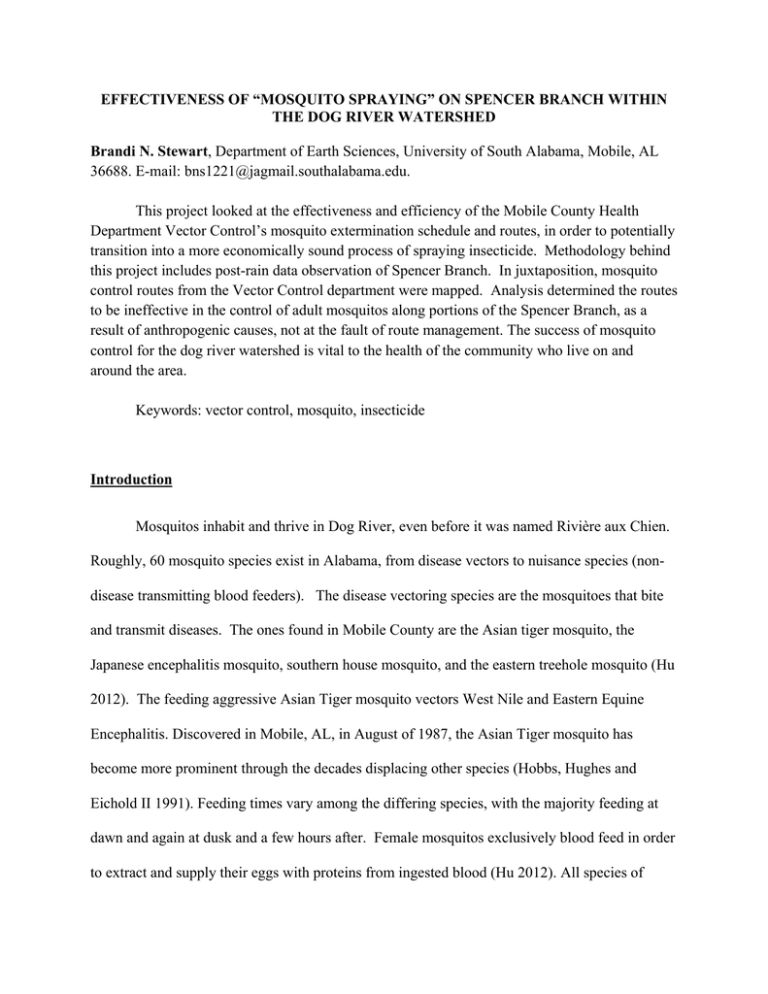
EFFECTIVENESS OF “MOSQUITO SPRAYING” ON SPENCER BRANCH WITHIN THE DOG RIVER WATERSHED Brandi N. Stewart, Department of Earth Sciences, University of South Alabama, Mobile, AL 36688. E-mail: bns1221@jagmail.southalabama.edu. This project looked at the effectiveness and efficiency of the Mobile County Health Department Vector Control’s mosquito extermination schedule and routes, in order to potentially transition into a more economically sound process of spraying insecticide. Methodology behind this project includes post-rain data observation of Spencer Branch. In juxtaposition, mosquito control routes from the Vector Control department were mapped. Analysis determined the routes to be ineffective in the control of adult mosquitos along portions of the Spencer Branch, as a result of anthropogenic causes, not at the fault of route management. The success of mosquito control for the dog river watershed is vital to the health of the community who live on and around the area. Keywords: vector control, mosquito, insecticide Introduction Mosquitos inhabit and thrive in Dog River, even before it was named Rivière aux Chien. Roughly, 60 mosquito species exist in Alabama, from disease vectors to nuisance species (nondisease transmitting blood feeders). The disease vectoring species are the mosquitoes that bite and transmit diseases. The ones found in Mobile County are the Asian tiger mosquito, the Japanese encephalitis mosquito, southern house mosquito, and the eastern treehole mosquito (Hu 2012). The feeding aggressive Asian Tiger mosquito vectors West Nile and Eastern Equine Encephalitis. Discovered in Mobile, AL, in August of 1987, the Asian Tiger mosquito has become more prominent through the decades displacing other species (Hobbs, Hughes and Eichold II 1991). Feeding times vary among the differing species, with the majority feeding at dawn and again at dusk and a few hours after. Female mosquitos exclusively blood feed in order to extract and supply their eggs with proteins from ingested blood (Hu 2012). All species of mosquitos share the same 4-stage life cycle, varying in time between stages of 7 to 10 days depending on species (Hu 2012) . The sequence occurs as follows: egg raft/ single egg, larva, pupa, and adult (Qualls and Mullen 2006). An adult female mosquito lays an egg raft (a cluster of approximately 100 eggs) on flood prone soil or directly onto still water (Qualls and Mullen 2006). The egg grows and hatches into larva and develops into pupa. The pupa will emerge into an adult mosquito and will seek stagnant water to lay its egg rafts. Most mosquitoes can fly no more than about one to three miles, and often stay within several hundred feet of where they were hatched (Hobbs, Hughes and Eichold II 1991). The anthropogenic objects deemed necessary for social and economic development inadvertently hold small pools of stagnant water, excellent for mosquito gestation. Anthropogenic breeding pools can occur in 5-gallon buckets, garbage piles, storm drains, water retention basins, and solid concrete reinforced stream/river walls (Hu 2012). All of these elements apply to the Moore Creek tributary, Spencer Branch . Global efforts to control mosquito populations range from the simplest at source reduction and exclusion to the most scientific at eradication by genetic alteration, for example, “sperm less mosquitos” (Carpenter 2011)(Peterson, et.al 2006). The Mobile County Health Department (MCHD) Vector Control carries out local efforts of mosquito population control; efforts are a combination of source control by removing stagnant water, exclusion by window screens and extermination by insecticides. The MCHD’s Vector Control disperses an ultra-low volume aerosol insecticide by mounting equipment onto trucks and driving through neighborhoods, this is what many know as, “Mosquito Spraying” (Mobile County Health Department: Vector Control 2015). The insecticide exterminates the adult mosquitoes, but does not reach the eggs, pupae and/or larvae remaining in the standing water (Mobile County Health Department 2015). As a result, new mosquitoes will continue to hatch. According to Vector Control, its employees drive as many as 50 unique routes across 1,200 square miles of the county. Inspectors who test ditches, swamps and other aquatic environments for mosquito eggs, larvae, and pupae construct portions of the routes. However, derivations of the routes are habitually from citizen complaints of mosquitos. For areas inaccessible by vehicle, such as marshes and coastal areas, a department-owned airplane distributes insecticides (Mobile County Health Department 2015). Research Question The question posed, are the 2 different insecticide routes, North Cottage Hill Route and South Cottage Hill Route, effective in exterminating mosquitos in and around the armored stream, Spencer Branch? Methods Routes and schedules were retrieved from MCHD Vector Control website. The routes were in a list format, for example North (Hillcrest Rd/Cottage Hill Rd) 36609 and South (Hillcrest Rd/Cottage Hill Rd) 36693. Director Folse described Cottage Hill Rd and Hillcrest Rd as dividers for the zip codes, “North” referring to the streets north of Cottage Hill Rd with “South” referring to streets south of Cottage Hill Rd and Hillcrest Rd marking the extent of the route to the west. To understand this concept spatially, route layers were created using the road layer from Mobile City GIS department. This was done by first creating a 1,000 foot buffer around Spencer Branch in ArcGIS 10.2. This buffer was used to clip the road layer and saved as a shapefile thus creating a section that could be split using a Boolean expression (if zipcode = 36609 then routeName = “North” etc.) This created the routes North 36609 and South 36693 under the specification of Director Folse. Statistical data on mosquito complaints by residences surrounding Spencer Branch were collected for the past 4 years, since the routes were revised to their current state. In 2010, the routes in this study were created by splitting off corners from other routes, because off workload constraints (Folse 2015). One year after the revised routes were in place calls decreased by 22%. Two years post-revision the calls decreased by 15% from the previous year’s count. In 2013, calls increased by 11% and another increase of 23% for 2014. There have been no calls for 2015. The sites for post rain observations were chosen based on accessibility to the stream from the road. Sites were created by making a 2 foot buffer around Spencer Branch and clipping that buffer with the road layer, once clipped the shapefile was transformed into a point layer in ArcGIS 10.2. This created 5 points where the road intersected with the stream. Observations for the five sites were at intervals of 1 day, 3 days, and 5 days after a precipitation event to determine if Spencer Branch contained standing water. On the only two occurrences where post rain observations could extend to 7 days post rain I walked the extent Spencer Branch. The map n be seen in figure 1. Results Post rain observations were typically cycled at 3 days due to new precipitation events for 12 sets of observations. Sets are defined as the observation time between precipitation events (1 set = 1 day, 3 day, 5 day post rain observation or 1 set = 1 day, 3 day, 5day). 7 day post rain observations were done by walking the extent of Spencer Branch, no standing water was found in these areas. Trash build up was noted and photographed at all 5 sites and multiple points along the fence guarding Spencer Branch. No standing water was found at any site during the course of this study. Post rain observation sites can be seen in figure 1. Fig 1: Map of Study Area: Spencer Brach and its surrounding neighborhoods. Conclusion Analysis of statistical call volume for mosquito reports determined the routes to be ineffective in the control of adult mosquito infestations along portions of Spencer Branch. The cause for this was not the standing water inside the armored stream, Spencer Branch, but the homes surrounding the area. According to 12-post rain observation sets and the two walking reports remaining water run off did not appear to be standing before another precipitation event occurred. The cause for the mosquito infestation was investigated further. Investigation revealed it is anthropogenic objects that cause the infestations, but it was not the armored stream. Spencer Branch is flanked by neighborhoods for the majority of its length. These residents live and play in the back yards of their homes, many which share a fence with Spencer Branch. It is because of these anthropogenic activities, water remains trapped thus decreasing the effectiveness of the aerosol pesticides dispersed by the MCHD vector Control department. Figure 3 depicts an example of many of the trash piles alongside Spencer Branch. Fig 3: The Source of the Problem. The illustration (right) shows places around the home water becomes trapped and mosquitoes can breed. Photograph (left) depicts trash build up along the fence. The increases from 2012 in the mosquito complaints are evidence to show the decrease in effectiveness of the ultra-low volume spray routes. Director Folse agrees it is not standing water in the stream that has caused the decrease in route insecticide effectiveness but the residence’s lack of education to the cause of mosquito breeding. Correlations in the decrease of mosquito complaints for 2010 and 2011 are seen with an increase in public awareness campaigns started in late 2010, for standing water removal done by the MCHD. The campaign started to slow in the latter portion of the 2011 mosquito season. Mosquito complaints increased in 2012, 2013, and 2014. Education on preventative measures for mosquito breeding is the way to increase insecticide route effectiveness. References Cited Carpenter, Jennifer. "BBC News Science & Environment." www.BBC.com. August 8, 2011. http://www.bbc.com/news/science-environment-14422440 (accessed February 25, 2015). Folse, Jerry, interview by Brandi Stewart. Mosquito Aerosol Pesticide Truck Routes in and around Spencer Branch (April 1, 2015). Hobbs, J.H., E.A. Hughes, and B.H. Eichold II. "Replacement of Aedes aegptyi by Aedes albopictus in Mobile, Alabama." Journal of the American Mosquito Control Association 7, no. 3 (September 1991): 488-489. Hu, Xing Ping. Mosquitos In and Around Homes ANR-1116. Public Service Announcement, Auburn: Alabama Cooperative Extension System , 2012. Mobile County Health Department. MCHD Mosquito Control. 2015. http://mchd.org/General/default.aspx?type=Mosquito%20Control%20%20General%20Information&index=59 (accessed 02 13, 2015). Mobile County Health Department: Vector Control. Mosquito Control Spray Truck Routes. 2015. http://mchd.org/General/default.aspx?type=Mosquito%20Control%20%20Spray%20Truck%20Routes&index=61 (accessed 3 13, 2015). Peterson, Robert, Paula Macedo, and Ryan Davis. "A Human-Health Risk Assessment for West Nile Virus and Insecticides Used in Mosquito Management." Environmental Health Perspectives (The National Institue of Environmental Health Sciences (NIEHS)) 114, no. 3 (March 2006): 366-372. Qualls, Whitney A., and Gary R. Mullen. "Larval Survey of Tire-Breeding Mosquitoes in Alabama." Journal of the American Mosquito Control Association 22, no. 4 (2006): 601608.

